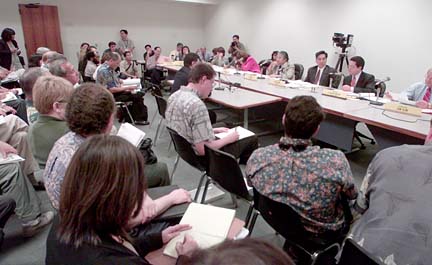


|
ACLU offers traffic According to Honolulu attorney Earle Partington, the best advice for those who want to challenge their traffic photo citations is to pretend you're an Enron executive.
camera advice
The forum was held to help drivers
know their rights under
the state's new programBy Rod Antone
rantone@starbulletin.comIn other words, invoke the right to remain silent and force the court to prove your guilt.
"Stand on the presumption of innocence," said Partington last night during an American Civil Liberties Union forum. "Say, 'Prove I was driving the car.'"
About 170 people showed up at the Blaisdell Center Pikake Room to hear Partington, criminal defense attorney Brook Hart, and ACLU legal director Brent White give advice about how to go about challenging a photo citation and to answer questions about the traffic cameras. The crowd which listened and sometimes applauded was a mixture of those who actually received a photo citation and others who just wanted to hear more about their rights.
"I don't really speed," said Jim Propotnick, a retired U.S. marshal who sat in the front row. "I just object to government being a Big Brother. I don't think it has any place in a democracy."
"I just need some information so I know what I can do," said Cindy Lee, a Kaimuki resident who received a citation for going eight miles over the speed limit on Jan. 7. "I was coming home from a funeral in Kaneohe with my mom when I got it.
"My record is clean, I'm not a speeder and I'm not a racer. I just feel like I wasn't getting a fair break."
The panel detailed the citation process, starting from receiving the citation all the way to making an appeal to the Hawaii Supreme Court. The first step for motorists is to address the ticket by way of mail, or through an informal hearing at traffic court.
Hart suggests that the simplest way to get through the first step of the process is to contest the ticket by mail. Hart says those wishing to challenge the citation should include a written statement which says something like, "There is insufficient evidence to show that I was the driver of the vehicle," and to maybe add "I believe the evidence presented is untrustworthy, given the financial incentives of the contractor."
White, Hart and Partington also said that the Department of Transportation was incorrect when it stated on the citation that the person receiving it is legally required to sign a "Declaration of Vehicle Operator Identification." In other words, if the registered owner was not driving the vehicle at the time of the citation, he or she must write down who was.
"The DOT has lied," said Hart. "That is not true."
The ACLU states in a handout that motorists can fill that particular part out if they want to, but cannot be forced to do so. Something Paul Guillermo of Aiea said he's glad to hear.
"I get cited but I'm not driving the car," said Guillermo. "I don't have to tell them who's driving, I have that right.
"I will fight this."
Those attending the meeting were warned however, that these traffic camera citations are completely new to the Hawaii judiciary, and that it is anyone's guess as to how judges will handle these cases. Those who choose to challenge their photo tickets and lose, will not only have to pay the speeding fine, but likely court costs and for subpoenas as well.
But some say the cost is worth the fight.
"It seems that everywhere we go, Big Brother is watching," said White. "It is up to us to decide whether these cameras are here to stay."